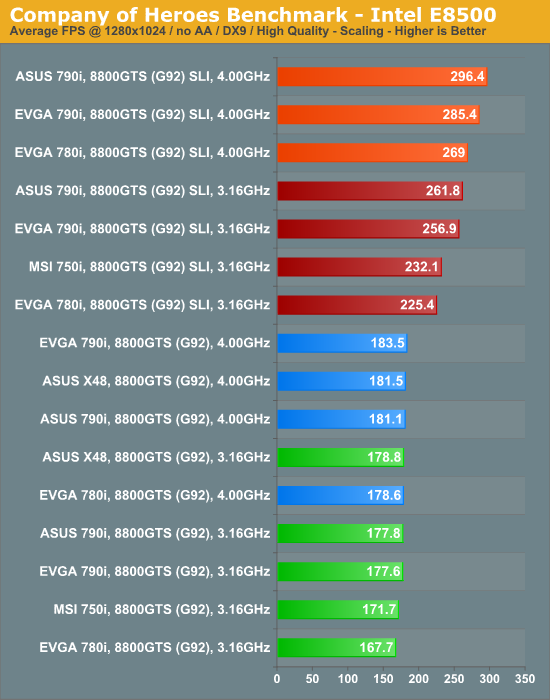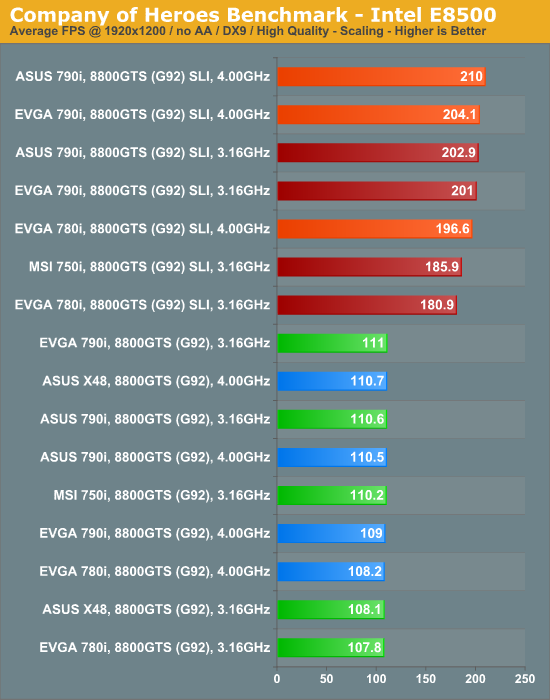ASUS Striker II Extreme: Mucho Bang, Mucho Bucks
by Kris Boughton on April 11, 2008 7:00 AM EST- Posted in
- Motherboards
Game Testing - Company of Heroes: Opposing Fronts
Company of Heroes: Opposing Fronts arrived last year and remains one of the best samples of the genre we have ever played. We find the game to be extremely GPU intensive and a hefty CPU is definitely required as well. This title contains a built-in performance test that makes use of the game engine, generating several different scenes representative of the in-game experience, which we believe provides a very good indication of just how well the system will perform during actual play. We use the DX9 rendering engine for testing purposes as the DX10 code path can quickly bring even the fastest system to its knees.

Unlike some other titles we have tested, Company of Heroes shows signs of being GPU-limited at lower resolutions (1280x1024) where the CPU is usually the bottleneck. Increasing our E8500's frequency alone from 3.16GHz to 4.00GHz did little to improve frame rates. The game did however exhibit excellent performance scaling with the use of two 8800GTS 512MB (G92) graphics cards in SLI. Once again, the two newest 790i boards had no trouble distinguishing themselves from the pack, outscoring the 780i- and 750i-based boards clock-for-clock by as much as 10%.

Moving to the higher 1920x1200 resolution undeniably places a larger share of the performance burden on the graphics subsystem. While average frame rates do decrease, scaling with SLI enabled comes very close to the magical, theoretically maximum of a full 2x increase in performance.

Even our quad-core QX9770 showed gains with Company of Heroes, demonstrating why this gaming engine deserves all the praise we can muster. The two 790i-based motherboards continue to hold a solid 10% lead over the similarly configured 780i board as well. In fact, the EVGA 780i board is unable compete at the highest 4.0GHz overclock - we just could not manage to keep the board stable long enough to complete the benchmark.

At 1920x1200, the quad-core results closely resemble those taken from the dual-core testing, which supports our earlier statements regarding the heavy GPU limitations at this resolution.










23 Comments
View All Comments
takumsawsherman - Saturday, April 12, 2008 - link
But for $400, you only get Firewire 400. Is that like a key, or something? If we pay $800 for a board, will they finally feel as though they can afford to add Firewire800, as Gigabyte did on their $200 boards like 3 or 4 years ago?When they talk about adding firewire itself to a board, does it never occur to them that a faster variation has existed for 5 or 6 years now? How insulting.
Grandpa - Saturday, April 12, 2008 - link
It doesn't matter what the price, performance, make, or model. If the board is unstable I don't want it! I had an Abit board once with a VIA chipset. It corrupted data when large files were transferred between drives. Several BIOS updates later, with the performance down to a crawl, it still corrupted data. Because of that ugly bad memory, stability is number one important for me. So this review is very relevant to others like myself.Super Nade - Friday, April 11, 2008 - link
As far as I know, the capacitors you mention are made by Fujitsu's Media division (FP-Cap series), not Fairchild semiconductor. Fujitsu did try to gobble up Fairchild in the 80's, but the US government killed the deal. Apart from this, I am not aware of any connection between these two companies.Here is the link--> http://jp.fujitsu.com/group/fmd/en/services/capaci...">http://jp.fujitsu.com/group/fmd/en/services/capaci...
S-N
Stele - Saturday, April 12, 2008 - link
Super Nade's right. The vendor marking on the capacitors - which have been the same for almost all such solid electrolytic polymer caps used on Asus boards for some time now - is very much that of Fujitsu: a letter 'F' in Courier-esque font between two horizontal lines.Interestingly - and confusingly - however, once upon a time this logo was indeed that of Fairchild Semiconductor... the deal that almost happened in the 80s may have something to do with Fujitsu's current use of the said logo. Either way, Faichild Semi have long since changed to their current logo (a stylised italic 'f') so today, any current/new electronic/semiconductor component carrying the F-between-bars logo is almost certainly a Fujitsu product.
jojo29 - Friday, April 11, 2008 - link
Just wondering how the Anandtech's Choice P5E3 Premium ( which i plan on buying) stacks up against this Striker? Any comments? Or did i miss something in the aricle as i was only able to skim through it, as im at work atm, and dontcoughwantcoughtogetcaughtbymybosscough...kjboughton - Friday, April 11, 2008 - link
We used one X48 motherboard in this review and it was the ASUS P5E3 Premium. Enjoy the full read when you make it home. ;)ImmortalZ - Friday, April 11, 2008 - link
You mention that overclocking the PCI-E bus provided tangible performance benefits on the EVGA board.Did you read about the rumblings around the net about some G92 based cards overclocking their GPU with the PCI-E bus? There are supposedly two clock sources for these type of cards - one on board and the other slaved to the PCI-E bus.
Are you sure that the performance improvement is not because of this anomaly?
CrystalBay - Friday, April 11, 2008 - link
Hi Kris, while UT3 does scale very well with multi-core. The game it self has no DX10 support as of yet. Hopefully EPIC will will enable it in a future update...Glenn - Friday, April 11, 2008 - link
All the benchies and comparisons are great, but how does it compare to a P35 board? A 965 or X38 board? I doubt you will convert those that already own an X48 and I (P35) have no point of reference within this article to see if I'm 5, 10 or 25% behind the preformance curve?Rolphus - Friday, April 11, 2008 - link
Interesting review... only one question though. Why use the 32-bit version of Crysis on Vista x64? Is there an issue with the 64-bit version that I don't know about?